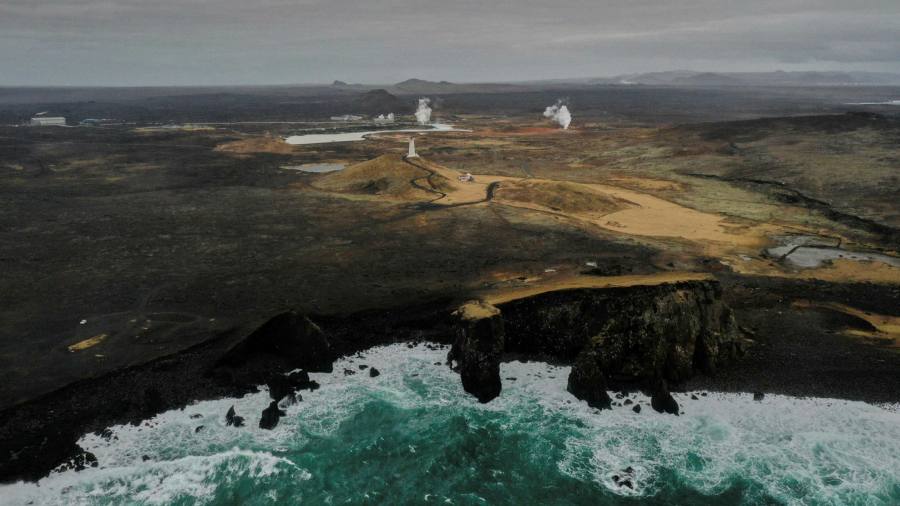[ad_1]
Such has been the frequency of the earthquakes that have struck Iceland in recent weeks that locals have taken to debating in the street whether a particular tremor was a 3.5 or a 4 on the Richter scale.
“Never before have so many people in Iceland experienced so much seismic activity,†said Thorbjorg Agustsdottir, a seismologist at the government-run Iceland GeoSurvey who made the observation. “They’re getting tired of being woken up and ask: when’s it going to stop?â€
More than 34,000 quakes have been recorded on the north Atlantic island in the past two weeks alone, most of them on the south-west Reykjanes peninsula that includes the capital Reykjavik, the international airport at Keflavik and the Blue Lagoon tourist attraction.
So far, they have been relatively small and have not been followed by a volcanic eruption. Yet volcanologists believe an eruption on Iceland is becoming more likely as magma moves to the surface, and that the sheer number of quakes may portend a prolonged period of increased seismic activity.
The magma below the Reykjanes peninsula was within one or two kilometres of the surface and an eruption could happen any time. Melissa Anne Pfeffer, an atmospheric volcanologist at the Icelandic Met Office, said the magma intrusion was about 7km long, up to 2km deep but only 1 metre wide.

Volcanic activity is a well-known risk on Iceland, with scientists monitoring more than 30 active systems across the lava-strewn island 24 hours a day. Iceland is one of the leading locations for studying volcanoes, alongside the likes of Hawaii, Japan and Indonesia.
For those outside the country, news of the increased seismic activity will revive memories of the Eyjafjallajökull eruption a decade ago. Then, the volcano spewed so much ash into the atmosphere that it led to the closure of most of Europe’s airspace for days, leaving holidaymakers stranded.
That eruption also strangely spurred the decade-long tourism boom for the island that was only ended by the Covid-19 pandemic.
Evgenia Ilyinskaya, a volcanologist who grew up on Iceland and now works at the University of Leeds in the UK, reassured that any eruption this time “would be nothing like†the 2010 event, as it would not produce any ash.
But she added that the position of the seismic activity — close not only to Reykjavik and the country’s main airport but also to power plants — meant one should be considered “dangerousâ€.

The volcanic system on the Reykjanes peninsula has not experienced an eruption since about 1188, and experts believe that activity occurs about every 800 years, and then lasts for years and even decades.
Any eruption could well go initially undetected by scientists’ instruments; the initial outburst at Eyjafjallajökull was spotted by a local farmer in the dark. Dozens of webcams are monitoring the area of current activity, and the interest from the Icelandic public and media remains elevated.
Yet volcanoes are rarely fatal on Iceland due to extensive modelling and simulations of lava flows, as well as detailed evacuation plans for vulnerable areas. Latest predictions suggest no lives would be threatened by an eruption.
Agustsdottir said the area was “one of the best places to have an eruption†as it was much less dangerous than one that occurs under a glacier, which raises the chance of ash and gas clouds.
Yet the current earthquake swarm is still the biggest in a populated area of Iceland in living memory, causing many to be woken in the night and some to even complain of seasickness.
“It’s quite annoying . . . to have your house swaying all the time,†Agustsdottir said of residents in the town of Grindavik that is the worst affected by the tremors.
She pointed out that scientists were still learning about the geology of Iceland, one of the world’s youngest countries that was formed on the mid-Atlantic ridge between the North American and Eurasian tectonic plates.
“There is so much more to discover in Iceland. Iceland is like a laboratory,†said Agustsdottir.
She joked that any volcanic outburst could well be “a perfect tourist eruptionâ€, allowing people to take a day trip from Reykjavik to safely watch it.
[ad_2]
Source link





